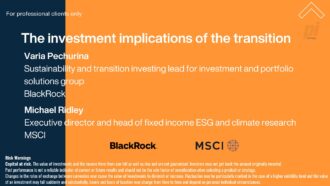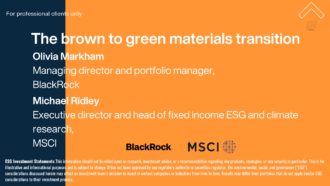BNP Paribas Asset Management’s Philip Dawes, head of UK sales, and Julien Halfon, head of pension solutions, explain why trustees should be making CDI part of their investment strategy.
What should trustees do to avoid being among the 85% of defined benefit (DB) pension schemes that are forecast to be cash-flow negative by 2027?
Many DB pension schemes that have de-risked over the past decade using liability-driven investment (LDI) are now holding negative-yielding assets. They are matching their liabilities, but not achieving optimal returns.
Given that pension schemes are increasingly cash-flow negative and private credit is becoming more available, there are better ways of generating the cash-flows needed.
BNP Paribas Asset Management advocates using a cash-flow driven investing (CDI) strategy that includes illiquid investments to generate not only incremental returns and spreads over publically-listed assets, but also to reduce volatility in portfolios.
Illiquid assets are typically mark-to-model on a monthly basis and (being idiosyncratic) can offer noticeable diversification benefits. Incorporating CDI into portfolios alongside LDI and growth assets can therefore increase the Sharpe ratio of the overall portfolio.
How is BNP Paribas Asset Management helping institutional investors meet their funding needs?
We have invested in infrastructure debt, commercial real estate debt, mid-market loans in the US and Europe, UK SME loans, asset-backed securities and mortgaged-backed securities for many years, so we have a range of underlying assets that we can draw upon to build CDI portfolios.
The wider BNP Paribas Group has 45 people originating commercial real estate loans across Europe. We have first right of refusal over this pipeline of transactions, which helps when tackling one of the biggest issues with illiquids: origination.
There simply are not enough of these assets for everyone to switch into CDI from an LDI approach. But thanks to our access to the wider group’s assets, we have access to a broad range of assets that we can customise to meet our client’s cash-flow requirements and attribute to underlying CDI portfolios.
For example, the bank has a team originating US mid-market loans, that have been active for three decades. We can analyse these assets in terms of returns, defaults and recovery rates to help construct robust portfolios. Plugging into the bank gives us credibility in terms of track record and visibility of the risk/return numbers. So we have the capability not to just build the underlying portfolio, but to manage risk on a holistic basis, too.
Is there a one-size-fits-all solution to CDI?
No. Every pension fund is different. If we apply the same portfolio composition strategy to all pension schemes, we will never meet our clients’ specific objectives. CDI typically suits mature schemes that are close to fully funded. BNP Paribas Asset Management has a track record of modelling solutions for investors, having been managing LDI mandates for more than 15 years.
Building a customised solution is better than being a market taker. For example, the typical tenor of a commercial real estate loan is five to seven years and it usually bears a floating rate. That is not optimal to build a CDI portfolio. In that context, we work with the wider group on individual transactions to generate long-dated fixed rate tranches that match an investor’s liabilities.
Is CDI the answer to all of an institutional investor’s needs?
Absolutely not. It is very unlikely that a £5bn DB pension scheme would put 100% of its portfolio into CDI. What we maintain is that for the first 10 years matching liability cash-flows can be better achieved using illiquid credit assets to generate better riskadjusted returns. This is not going to be appropriate to all of a DB scheme’s assets. It is more likely to concern 10% to 15% of a portfolio.
We would envisage cash-flow driven investing forming part of a larger portfolio alongside existing LDI assets and possibly a small growth strategy, depending on the funding level.
If adequately structured within a captive insurance company, a CDI strategy can also be seen as an alternative to a full-fledge buyout (which remains expensive). In the case of full-fledge buy-out, the employer may need to increase the scheme funding level (after a decade of underfunding). A captive solution may require less upfront funding than a buy-out and rely more on the CDI assets to build up the required capital.
Should trustees be concerned over the illiquidity of many CDI strategies?
Illiquidity can sometimes be over-stated as a risk. It is indeed the illiquidity of private credit that we seek to exploit. Thus clients should decide what level of illiquidity they can accept and attribute a proportion of assets relative to this budget.
Being marked-to-model (typically monthly), illiquid credit portfolio volatility (and therefore funding volatility) is lowered. Many real assets are highly covenanted and stable, so one is not necessarily introducing more incremental risk into the portfolio by investing in illiquid credit.
We have developed an approach to CDI that is managed with respect to a client’s existing flight-path and manage the portfolio with this in mind, altering asset allocations over time keeping the endgame in focus whilst providing holistic risk management.
What should a trustee look for when choosing a CDI manager?
The key is origination. One of the drawbacks with illiquid credit is that historically they have been accessed as single asset classes.
A £300m commitment to a private credit provider without a reliable origination engine runs the risk that after three years they have only deployed £50m and so return £250m to the client. There is an important opportunity cost associated with such a failure.
Our view is that with a broad discretionary mandate we can approach the market on a relative-value basis such that if UK infrastructure does not look appealing we can look to mid-market loans or other illiquid segments to generate those returns at a point in time.
The other risk with origination is that if you provide £300m to the wrong provider it may compel them to generate a fee at any cost. They could therefore decide to deploy the cash into lower quality assets. In that respect, we have developed a synthetic approach to many of these underlying asset classes, so if we don’t find value in infrastructure debt, for example, we can hold liquid alternatives, such as utility bonds, until spreads recover. That allows us to generate incremental returns whilst maintaining a form of liquidity similar to corporate bond portfolios.
So origination is key, as is risk management. A good provider has access to the underlying assets, and can holistically manage the portfolio with respect to other assets that a client may have. Our solutions team would work with a data feed from the client’s LDI portfolio to check what credit exposure there is and how it would interact with the CDI portfolio. The interaction between the LDI and the CDI portfolios is crucial for all DB schemes.
This is one of the cases where an asset manager needs to have boots on the ground. They need to understand all a client’s objectives and constraints so that they can model a suitable solution for them. This does not guarantee success but it certainly contributes to increasing its probability.
If gilt yields improve, should institutional investors reduce their allocation to real assets in favour high-grade bonds?
It comes down to what the client’s interest rate expectations are over the next 10 years. Is it realistic to expect that interest rates will go back to 6%? The risk of interest rate rises has been overstated over the past seven years and is likely to be so for the coming months and years.
When considering investing in illiquid credit assets, it is crucial to be realistic about the interest rate expectations and how much incremental value these illiquid assets will generate, even in a rising rate environment.
Commercial real estate debt, for example, typically has a tenor of five to seven years and is amortising, so within three years half of the investment is paid back. People underestimate how quickly they must recycle the cash, so the risk of interest rates rising and clients panic-selling is over stated. As a large proportion of those underlying assets would have amortised within three, four or five years, there is the ability within that portfolio to recycle that cash into assets that on a fixed-rate basis would benefit from rising interest rates. The investments do not lock the clients on day one into assets that would be fixed rate for the next 10 years.
How is CDI evolving?
The first generation of CDI approaches, as with any product, did not land on the optimal solution. Asset managers simply did not have the breadth of asset classes needed to build such a strategy. Essentially, the first CDI strategies were focused on corporate bonds.
Demand for higher returns and lower volatility means that today’s CDI offering is unrecognisable from that first wave. A broader range of underlying assets are used, many of which are illiquid. The strategy has evolved in other areas, too with excess returns, risk management and limited volatility now embedded.
Additionally the fundamentals have changed when it comes to sourcing and understanding the interaction between CDI, LDI and other asset classes.
There has been a long road to sophistication, and it is a journey that the industry is still taking as it seeks to improve how it generates a target return for taking less risk. Evolution and sophistication go handin-hand here.





